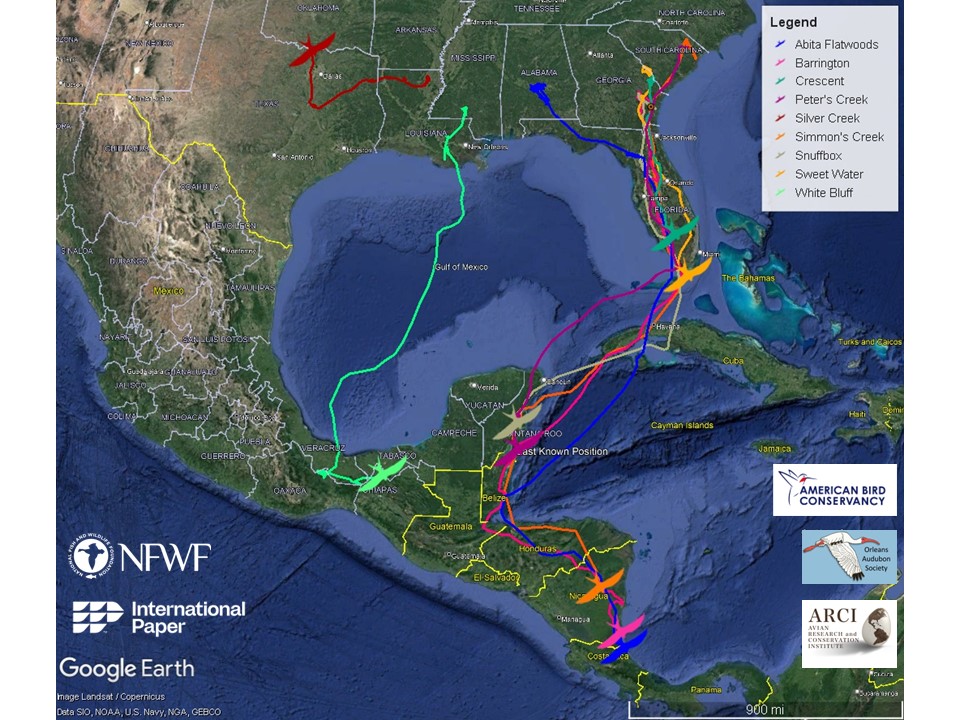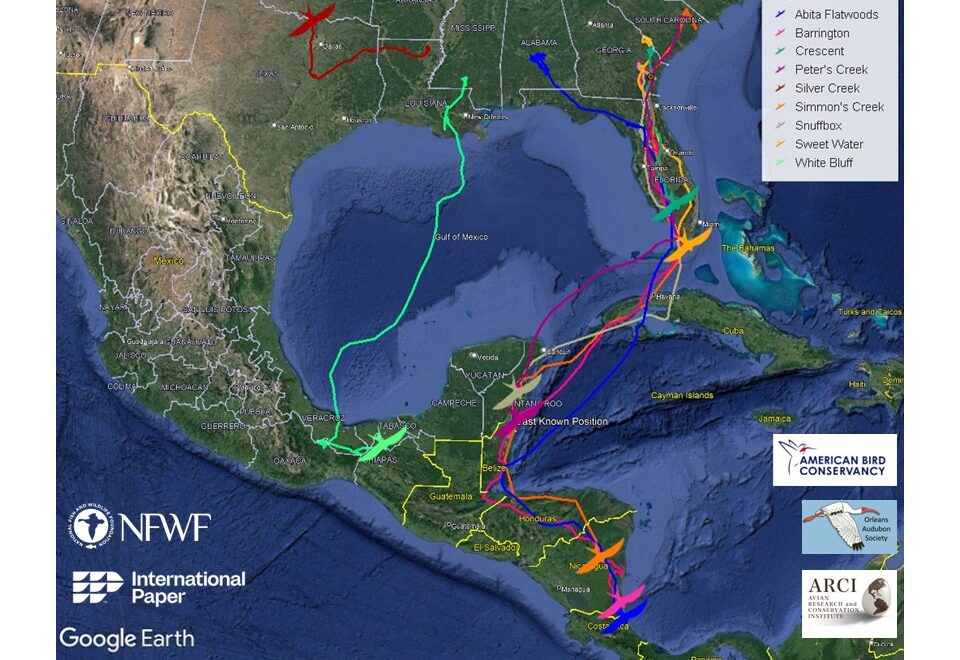Avian Research and Conservation Institute (ARCI) and Orleans Audubon Society (OAS) have partnered with the American Bird Conservancy (ABC) with funding from International Paper (IP) and the National Fish and Wildlife Foundation (NFWF) to support the study of Swallow-tailed Kites on working timber forests in the Southeastern US. See the back story.
Swallow-tailed Kite migration is well underway and our aerial research team of nine GPS-tracked birds all have their own migration story; some with suspense…see below:

White Bluff, a male tagged in Mississippi in 2024, began his southbound migration on August 9 at 10:00 AM, leaving Mississippi to spend the night on the Amite River in Louisiana. Next, he flew to the Barataria-Terrebonne Basin to visit known kite areas and spend two nights near Chackbay. Then, on August 12 at 12:00 PM, he departed Louisiana over Terrebonne Bay. He crossed the Gulf of Mexico in 2.2 days, making landfall in the State of Vera Cruz. After spending the night near Coatzacoalcos, he spent a few days in the State of Oaxaca feeding over agricultural fields. Then on August 18 he flew east to follow the Usumacinta River.
The Abita Flatwoods female tagged in Louisiana in 2023, left her breeding territory on July 6, immediately after her two young fledged, to head north and roost on a working forest in northern St. Tammany Parish. From here she continued to the same pre-migration territory she held in 2023, in central Alabama along the Alabama River. After feeding here for a month, on August 6, she flew to the Apalachicola River in the Florida panhandle and roosted there. On August 7 she flew to Gilchrist County, Florida and spent several days there. Then she headed south and left peninsular Florida on August 13. After crossing the Straits of Florida and passing over Cuba, she spent the night on the Isla de la Juventud. From here she crossed the Caribbean Sea to make landfall in Belize near Hopkins. Her last known location on August 19 was the Isla Machuca in Costa Rica.
The Silver Creek female, tagged in 2024, left Foxworth, Mississippi, one week after her release. On July 7 she headed west, crossing the Mississippi River to spend one night near Ferriday, Louisiana. From here she headed north to spend 3 weeks around Rayville, feeding mostly over fields along the Boeuf River. On July 31 she headed west to spend 3 days around Marshall, Texas. From here she passed through Waco, Dallas, Fort Worth and Denton, to eventually settle on the Red River. She has been holding a tight home range here near Sivells Bend and remains there as of September 1. She is the only GPS-tracked Swallow-tailed Kite remaining in the U.S.A. The first juvenile Swallow-tailed Kite to be tracked with a GPS-unit! See her story.
Crescent, a female from Jasper County, South Carolina was last in the Okaloacoochee Slough WMA near Immokalee, Florida on July 31. No data since then. We are hopeful that she is OK and safely moving through locations without the cell service necessary to upload her location data.
Sweet Water: a female from Burke County, Georgia was on her way across Florida Bay on August 15. Also no updates since then; most likely out of cell service for data upload. We will be on pins and needles until these two Swallow-tailed Kites upload location data once again.
Snuffbox Canal: a male from McIntosh County, Georgia left Georgia on July 24. We were happy to see that he included Gainesville, Florida on his travels to “wave hello” to ARCI. He rested and fueled for a while before leaving Florida due south from the Everglades on August 18. His route took him 7.5 miles west of the Florida Keys Hawkwatch platform (between 18:00 and 20:00) so it is unlikely that he was captured in their “Kite Flight” counts. His southern trajectory took him through to south Cuba out the Zapata Peninsula and west onto land south of Cancun, Mexico on August 21. He is now spending a stopover in the Sian Ka’an Biosphere Reserve.
Barrington: a male from McIntosh County, Georgia left the Altamaha River on August 8th and on August 13 he flew off from the Florida Everglades. He flew south and through Marathon Key where the Florida Keys Hawkwatch may have detected him however, he crossed at night between 22:00 and 23:00 which is quite unusual. We rarely track kites taking off over water after dark (however this is the third kite this year! See former blog). He crossed through Cuba west of Havana and out the southwestern tip making it to Quintan Roo on August 15. Instead of stopping to rest and refuel, Barrington continued south and is in southern Nicaragua.
Simmon’s Creek: a male from Georgetown County, South Carolina left his Great Pee Dee River pre-migration location on August 11 and wasted no time moving through Georgia and Florida. August 15, he left from the Florida Everglades across The Keys and was most likely counted by the Florida Keys Hawkwatch between 17:00 and 18:00 at the end of their count window. His route took him passed Havana, south through Cuba and out the Guanahacabibes Peninsula. He spent a night on Cozumel before reaching Quintana Roo, Mexico’s Sian Ka’an Biosphere Reserve. After six days there, he continued on and is currently in central Nicaragua.
Our latest Swallow-tailed Kite to leave the U.S was Peter’s Creek, a male from Georgetown County, South Carolina. He made his way south from his pre-migratory staging area on the Great Pee Dee River on August 22. He moved fast through Georgia and Florida. On August 25 he flew west-southwest from the Florida Everglades between the Florida Keys and Dry Tortugas National Park directly to northern Quintana Roo, Mexico 28 hours later. He spent six days in the Sian Ka’an Biosphere Reserve in the same area where Simmon’s Creek and Snuffbox Canal spent time. He is proceeding through Mexico.
The value of data collected by each individual kite extends above and beyond what we gather at one nest, on one working forest in the Southeastern U.S. The data accumulates each year, with each season and is expanding our knowledge of the entire U.S population of Swallow-tailed Kites that we have been tracking since the 1990’s. New foraging aggregations, roost sites, migratory stopovers, changes in migration corridors, and wintering destinations are all important features we can analyze with each GPS-tracked individual. We are grateful to our funding sources International Paper (IP) and the National Fish and Wildlife Foundation (NFWF) as well as the many working forest owners, land managers, and partners for making this project a possibility.


Where is Suwannee ?